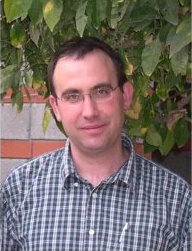Professor Ehud Gazit
The ScienceDaily article Could Amyloid Deposits Have Potential As Nanomaterials? said
Amyloid deposits in tissues and organs are linked to a number of diseases, including Alzheimer’s, Parkinson’s, type II diabetes, and prion diseases such as BSE. However, amyloids are not just pathological substances; they have potential as a nanomaterials. “The potential applications of these supramolecular assemblies exceed those of synthetic polymers,” state Ehud Gazit and co-author Izhack Cherny in the journal Angewandte Chemie, “since the building blocks may introduce biological function in addition to mechanical properties.”
Even in nature, amyloids are not merely abnormal, incorrectly folded proteins; they are physiological components of organisms. For example, they are an important protective material in the egg envelopes of insects and fish. They are also involved in the formation of the biofilms of many bacteria, a coating on the surface of the bacterial cells that protects them from antimicrobial substances and facilitates their attachment to surfaces.
Ehud Gazit, Ph.D. is Professor, Dept of Molecular Microbiology &
Biotechnology, Tel Aviv University (TAU), Israel and Visiting Scientist,
Center for Biomedical Engineering, Massachusetts Institute of
Technology (MIT), USA. He is on the Editorial Boards of
Journal of Bionanoscience,
Nanomedicine,
Current Chemical Biology
PLoS ONE, and
Amyloid.
He is also Vice President Elect for Research and Development of
Tel Aviv University.
The central dogma in the study of protein folding suggests that the
thermodynamically-favorable state of proteins under physiological
conditions is their folded one. However, there are number of cases in
which the favorable states of proteins are rather unfolded, partially
folded (e.g., “molten globular”, or misfolded (e.g., nonspecific
aggregates or amyloid fibrils). These observations lead to much interest
in the significance and mechanism of formation of such unfolded,
misfolded or partially folded structures in physiological as well as
pathological conditions.
In Ehud’s lab he utilizes a variety of biochemical, biophysical, and
molecular biology methodologies to study the mechanism and significance
of protein unfolding and misfolding. The experimental systems used are
diverse and the partial list includes several bacterial toxin-antidote
systems, type II diabetes-related amyloidogenic proteins and peptides,
and the VHL tumor suppressor protein. He also studies the mechanism of
non-specific aggregation of generic unrelated proteins. Another line of
research is directed toward the elucidation of the mechanism of action
of chemical chaperons and their effect on folding, aggregation, and
amyloid formation.
Ehud authored
Plenty of Room for Biology at the Bottom: An Introduction to
Bionanotechnology and
A possible role for π-stacking in the self-assembly
of amyloid fibrils,
coauthored
Casting Metal Nanowires Within Discrete Self-Assembled
Peptide Nanotubes,
Analysis of the Minimal Amyloid-forming Fragment of the Islet
Amyloid Polypeptide, and
Molecular Self-Assembly of Peptide Nanostructures: Mechanism of
Association and Potential Uses,
The structure and organization within the membrane of the helices
composing the pore-forming domain of Bacillus thuringiensis
δ-endotoxin
are consistent with an “umbrella-like” structure of the pore,
and coedited
Nanostructure Design: Methods and Protocols.
Ehud earned his
B.Sc. (summa cum laude) at Tel-Aviv University in 1991 and
his Ph.D. (with distinction) at the Weizmann Institute of Science,
Rehovot, Israel in 1997. From 1997 to 200 he was a Postdoctoral Fellow
at the Massachusetts Institute of Technology (MIT),
Cambridge, MA, USA.





